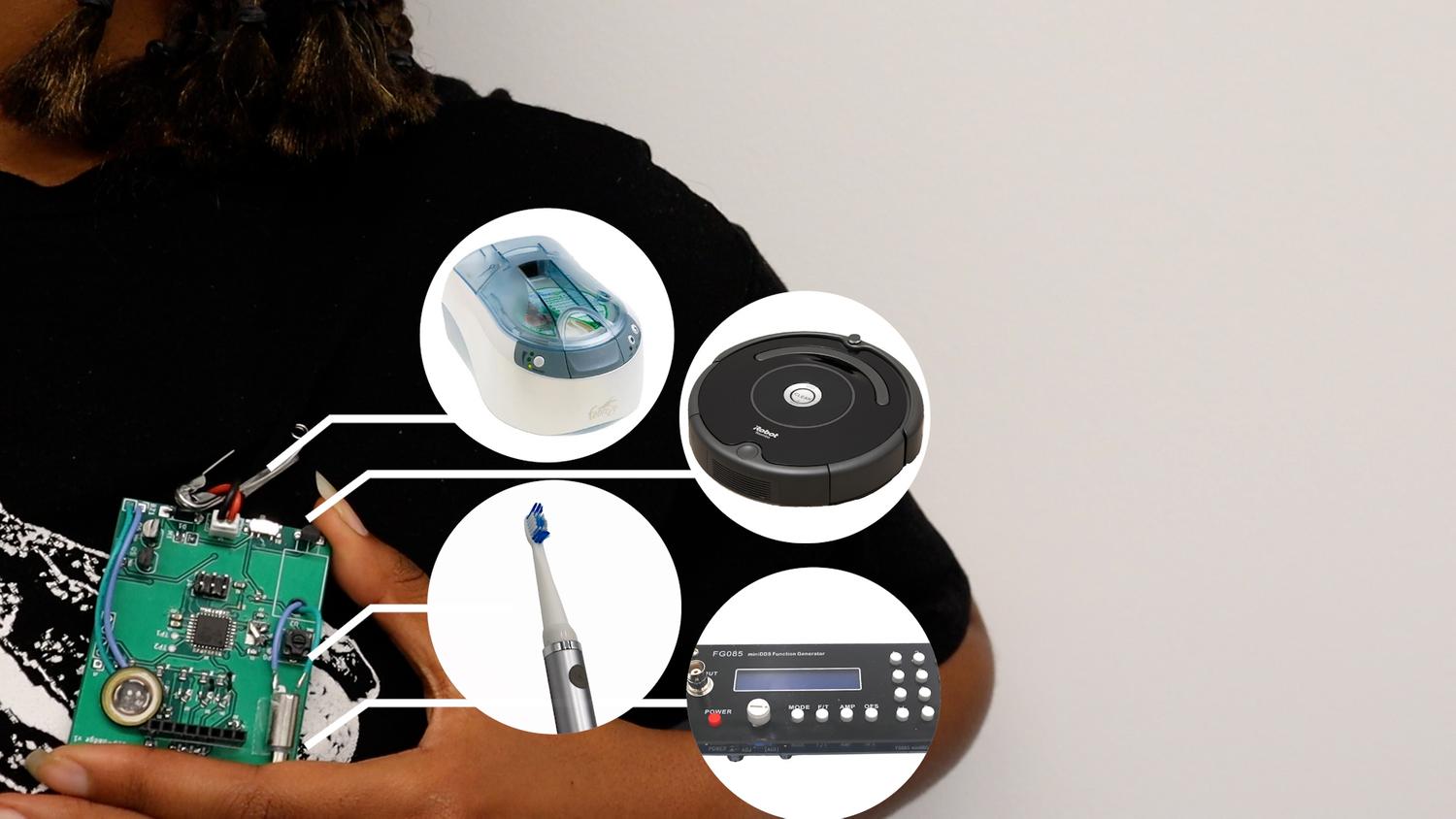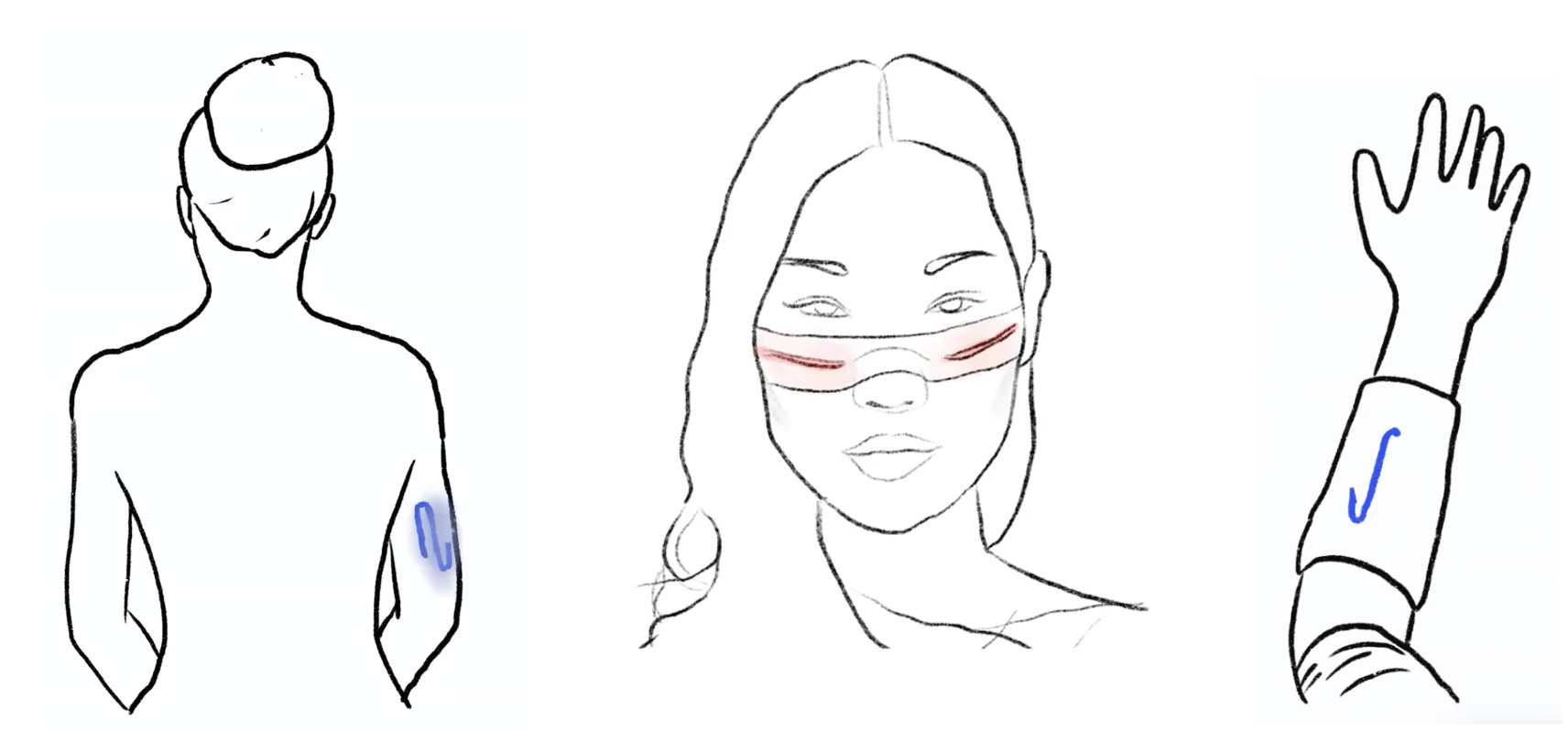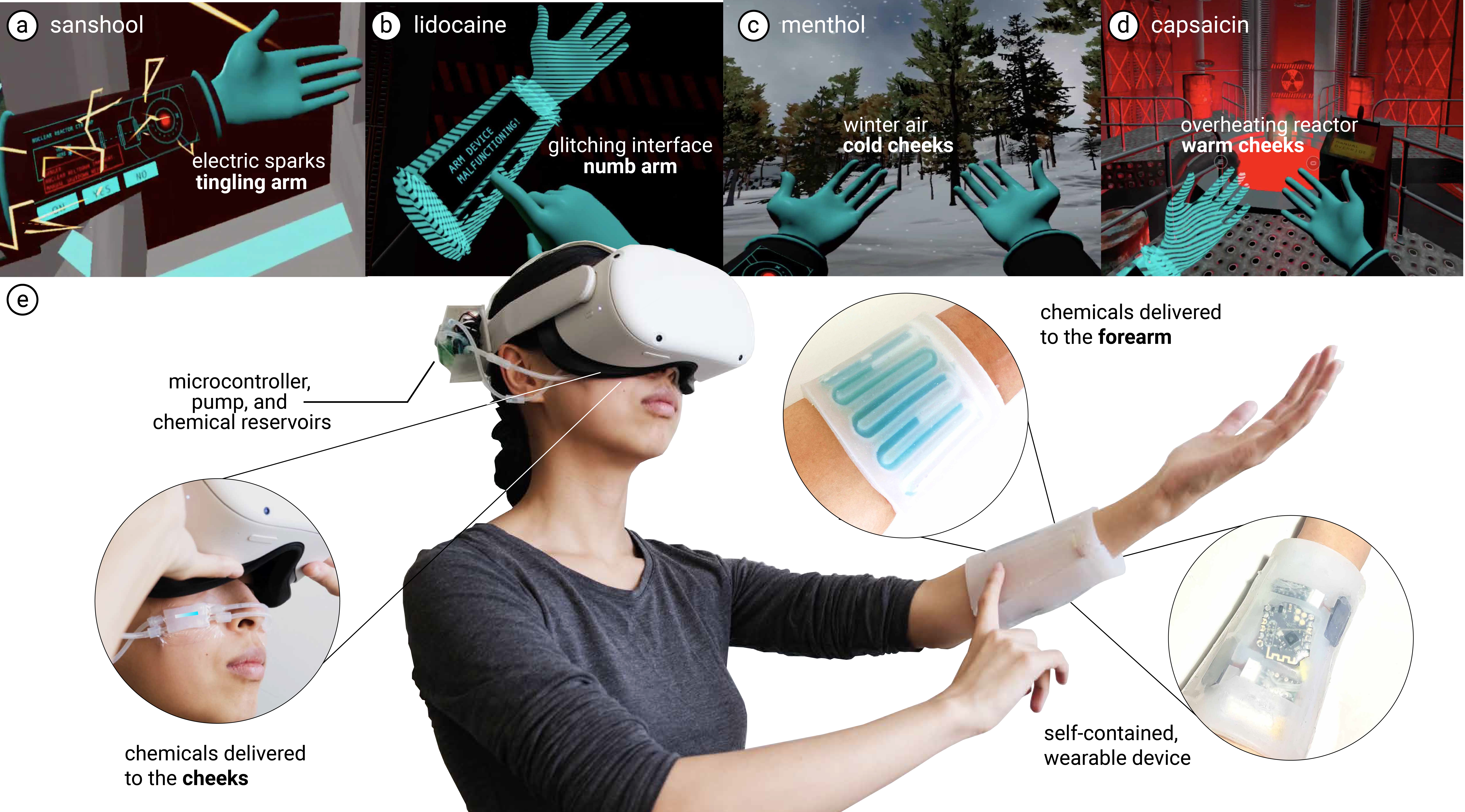Publications
︎︎︎Google Scholar PageI publish primarily at Human Computer Interaction conferences (CHI, UIST, etc.) as part of my research lab. Listed below are conference/journal publications and other writings (magazine articles, etc.).
Publications

9. Full Stack Recycling Approaches for Computing Devices.
Jasmine Lu, Pedro Lopes. In Proc. Conference on Communications of the ACM (CACM) ’25.[ paper ]
Currently, electronics recycling is primarily solved from a materials recycling approach. This is accomplished by taking the electronic device, melting it down, and extracting raw materials from it. While this method is useful for tackling recycling at large scales, it is incredibly inefficient. This recycling approach ignores the inherent functional modularity of electronic devices - that they are built on a stack. We propose an alternative vision of recycling - full stack recycling.

8. ProtoPCB: Reclaiming Printed Circuit Board E-waste as Prototyping Material.
Jasmine Lu, Sai Rishitha Boddu, Pedro Lopes. In Proc. Conference on Human Factors in Computing Systems (CHI) ’25.[ paper ] [ video ] [ talk ] [ code ]
We propose an interactive tool that enables reusing printed circuit boards (PCB) as prototyping materials to implement new circuits — this extends the utility of PCBs rather than discards them as e-waste. We designed a tool that takes a user’s desired circuit schematic and analyzes its components and connections to find methods of creating the user’s circuit on discarded PCBs (e.g., e-waste, old prototypes). We showcase how circuits could be implemented on a different board, implemented with minor interventions (trace-cutting or bodge-wiring), or implemented on a combination of multiple boards — demonstrating how our tool assists with exhaustive matching tasks that a user would not likely perform manually. Read more in ProtoPCB.

7. Unmaking Electronic Waste.
Jasmine Lu, Pedro Lopes. In Transactions of Computer-Human Interaction (TOCHI) ’24. Special Issue on Unmaking.[ paper ] [ talk ]
HCI primarily focuses on designing and understanding device interactions during one segment of their lifecycles—while users use them. Leaving significant space overlooked: when devices are no longer “useful” to the user, such as after breakdown or obsolescence. We argue that HCI can learn from experts who upcycle e-waste and give it second lives, exploring their practices through the lens of unmaking both when devices are physically unmade and when the perception of e-waste is unmade once waste becomes, once again, useful. Read more in Unmaking Electronic Waste.

6. Re-Envisioning the Role of a User in Sustainable Computing.
Jasmine Lu, Pedro Lopes. In IEEE Pervasive Computing Magazine ’24. Special Issue on Sustainable Computing.[ paper ]
We argue that the envisioned roles we attribute to users during user-centered design should encompass much more. In addition to the role of the “user of a device”, we can design for user-roles such as maintainers, repairers, and recyclers of interactive devices. We discuss this design shift through examples of two interactive systems we built to explore altering the role of the traditional “user” to that of caretaker and recycler. Additionally, we discuss mor roles and how these roles can encourage user to take on responsibilities to support more sustainable futures.

5. Designing Plant-Driven Actuators for Robots to Grow, Age, and Decay.
Yuhan Hu, Jasmine Lu, Nathan Scinto-Madonich, Miguel Alfonso Pineros, Pedro Lopes, Guy Hoffman. In Proc. Designing Interactive Systems (DIS) ’24.[ paper ] [ video ] [ talk ]
Designing plant-driven actuators presents an opportunity to create new types of devices that grow, age, and decay. Plant-robot hybrids that grow and decay incorporate unpredictable and gradual transformations inherent across living organisms and suggest an alternative to the design principles of immediacy, responsiveness, control, accuracy, and durability commonly found in robotic design. To explore this, we present a design space of primitives for plant-driven robotic actuators. Read more in Designing Plant-Driven Actuators for Robots to Grow, Age, and Decay.

4. ecoEDA: Recycling E-Waste During Electronics Design.
Jasmine Lu, Beza Desta, K D Wu, Romain Nith, Joyce Passananti, Pedro Lopes. In Proc. User Interface Software and Technology (UIST) ’23.[ paper ] [ video ] [ talk ]
E-Waste is the fastest growing consumer waste-stream in the world. Inside any device that might typically become e-waste, one can find dozens to hundreds of reusable components. Despite the abundance of components in e-waste, existing electronic design tools assume users will buy all components anew. To tackle this, we created a tool called ecoEDA that facilitates component reuse during the design process. Read more in ecoEDA: Recycling E-Waste During Electronics Design.

3. Integrating Living Organisms in Devices to Implement Care-based Interactions.
Jasmine Lu, Pedro Lopes. In Proc. User Interface Software and Technology (UIST) ’22.[ paper ] [ video ] [ talk ]
We explore how embedding a living organism (in this case a slime mold, Physarum Polycephalum) as a functional component of a device, changes the user-device relationship. In our design, the user needs to care for the living organism (through providing food and water) in order for the device to work. When healthy, the organism participates in the device’s functionality by acting as a physical wire that enables power to the watch’s heart rate sensor. As such, caring for the device is intrinsic to its interaction design —with the user’s care, the slime mold becomes conductive and enables the sensor; conversely, without care, the slime mold dries and disables the sensor, and resuming care resuscitates the slime mold.
Read more in Integrating Living Organisms in Devices to Implement Care-based Interactions.
2. Designing with Chemical Haptics.
Jasmine Lu. Design Research Society Bilbao ’22.[ paper ]
Chemical receptors exist all throughout our body and are embedded throughout our skin. In this paper, I discuss my recent explorations in chemosensory interfaces for the skin and what possibilities it enables for the interaction design community. I outline my process of designing with these sensations, discuss how the chemical haptics approach induces uniquely complex sensations, and speculate on chemosensory design futures.
1. Chemical Haptics: Rendering Haptic Sensations via Topical Stimulants.
Jasmine Lu, Ziwei Liu, Jas Brooks, Pedro Lopes. In Proc. User Interface Software and Technology (UIST) ’21.[ paper ] [ video ] [ talk ]
We propose a new class of haptic devices that provide haptic sensations by delivering liquid-stimulants to the user’s skin; we call this chemical haptics. Upon absorbing these stimulants, receptors in the user’s skin are chemically triggered, rendering distinct haptic sensations. We identified five chemicals that can render lasting haptic sensations: tingling (sanshool), numbing (lidocaine), stinging (cinnamaldehyde), warming (capsaicin), and cooling (menthol). To enable the application of our novel approach in a variety of settings (such as VR), we engineered a self-contained wearable that can be worn anywhere on the user’s skin (e.g., face, arms, legs). Read more in Chemical Haptics.
Workshops and Workshop Papers
10. Envisioning post-growth strategies for remediating electronic waste.
Jasmine Lu.Advancing Post-Growth Workshop, CHI2025
[ paper ]
9. Empowering End-Users Toward Roles in Sustainable Computing.
Jasmine Lu.Doctoral Consortium, DIS2024
[ paper ]
8. (W)E-waste: Creative Making with Wasted Computing Devices.
Jasmine Lu, Ilan Mandel, Wendy Ju, Pedro Lopes.Organized Workshop at C&C2024
[ paper ]
7. Computational Tools to Support the Repair, Reuse, and Recycling of Devices.
Jasmine Lu, Pedro Lopes.NSF Workshop on Sustainable Computing for Sustainability 2024
6. Future Paradigms for Sustainable Making.
Zeyu Yan, Tingyu Cheng, Jasmine Lu, Pedro Lopes, Huaishu Peng.Organized Workshop at UIST2023
[ paper ]
5. On engineering with slime mold rather than using slime mold.
Jasmine Lu, Pedro Lopes.Designing with more-than-human: Temporalities of thinking with care, DIS2023
[ paper ]
4. Temporalities of plant-driven robots that grow and decay.
Yuhan Hu, Jasmine Lu, Nathan Scinto-Madonich, Miguel Alfonso Pineros, Pedro Lopes, Guy Hoffman.Designing with more-than-human: Temporalities of thinking with care, DIS2023
3. E-waste is an HCI Problem Too.
Jasmine Lu, Pedro Lopes.Bringing Sustainability through, in, and of HCI into Conversation, DIS2023
2. Creating Pathways for Electronics Prototyping with Reused Components.
Jasmine Lu, Pedro Lopes.Beyond Prototyping Boards: Future Paradigms for Electronics Toolkits, CHI2023
[ paper ]
1. Living Bits and Radical Aminos: A Workshop on Bio-Digital Interfaces for Human-Computer Interaction.
Jack Forman, Pat Pataranutaporn, Phillip Gough, Raphael Kim, Fiona Bell, Netta Ofer, Jasmine Lu, Angela Vujic, Muqing Bai, Pattie Maes, Hiroshi Ishii, Misha Sra.Organized Workshop at CHI2023
[ paper ]
Other Articles (magazine, online blogs, etc.)
3. Technology is Not Neutral: Locating Sites of Resistance as Computing Students.
Jasmine Lu, Jiayi Li.ACM XRDS, Volume 30, Issue 4 (July-August 2024)
[ link ]
2. Learning to work with chemicals as a haptic technology.
Jasmine Lu, Ziwei Liu, Jas Brooks, Pedro Lopes.Interactions - Volume 29, Issue 4 (July-August 2022)
[ link ]
1. Achieving New Skin Sensations with Chemical Haptics.
Jasmine Lu.ACM UIST Medium Blog (October 2021)
[ link ]


